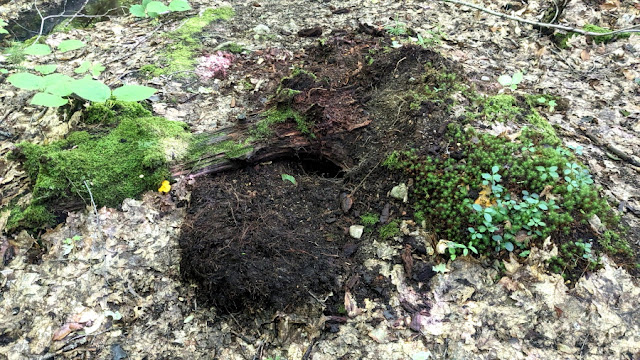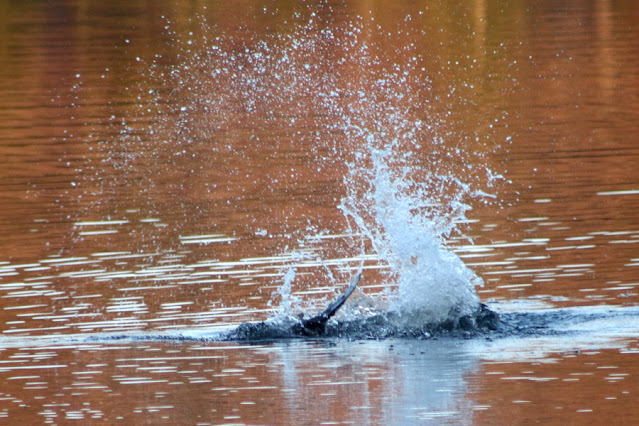This was supposed to be a cheery post about mountain hikes and close encounters with deer, bears, and wildfire smoke, as well as a beautiful paddle on one of our local lakes. On the way home from one of these hikes, in the Ossipee Mountains, we drove by Lake Kanasatka which I've driven by a hundred times but have never paddled, and it looked so inviting that the very next day I went back with my kayak to explore the lake. That's when things changed. Unloading my kayak the lake looked simply beautiful - it was sunny and calm with the lake reflecting a bright blue sky.
 |
| Lake Kanasatka looks beautiful reflecting the blue sky from a distance. |
But as I put my boat in the water, something wasn't right - the water at the launch was green.
It looked like a cyanobacteria bloom, but I thought it would be limited to right there where route 25 goes close by the lake. As I paddled up the shore line it didn't get better, in fact it got worse.
All the way up the west shore there were thick streams of cyanobacteria on the surface with more densely suspended throughout the water column, limiting visibility to about three feet.
As I approached the north end of the lake the wind had come up a bit, creating small ripples that were stirring things up somewhat but the bloom was present even there at the inlet fed by Wakondah Pond. I continued around and back down the east shore and as the lake became more sheltered from the breeze the bloom thickened again. The entire shore of Kanasatka is populated with houses, docks, and beaches, but not a single person was in the water on this gorgeous day except for a few teenagers over on the east side by Camp Quinebarge. The last camp session has ended so the swimmers were probably local residents.
Lake Kanasatka isn't a small pond where you might expect poor water quality: At 371 acres, it's bigger than Wicwas, as well as Pemigewasset, Winona, White Pond, and many other good size lakes in New Hampshire. If this can happen at Kanasatka, it can happen to all those water bodies and even larger lakes as water and air temperatures climb and runoff from development increases.
This bloom was reported by NH DES on August 7th on their healthy swimming map, so it has been present for three weeks and counting. It's a stark reminder that we must all be vigilant in protecting our natural resources. If you want to help, get in touch with NHLakes, or a land trust such as the Lakes Region Conservation Trust, or your town's Conservation Commission, or your local lake association. Whatever level of involvement you are comfortable with, you can help our lakes. You can learn more about cyanobacteria at the NH DES website here.
Enough doom and gloom, lets move on to something more pleasant. On that day hiking in the Ossipee Mountains we had clear skies with visibility over 75 miles.
 |
| Looking out over Castle in the Clouds from the Oak Ridge Trail. |
We could see all the way to Mount Monadnock from the outlook on the Oak Ridge Trail.
 |
| Lake Winnipesaukee and the Belknap Range. Mt. Monadnock is barely visible in the photo. |
Hiking up along the quiet trail we suddenly heard loud rustling in the trees above us. Linda said right away, "that's not a squirrel". Looking towards the sound I saw a large beech tree and we both knew what it was. Up through the thick leaves we could see a large dark blob. Yup, a black bear, staring right down at us.
 |
| A black bear, displeased to be disturbed from either its slumber or its lunch. |
One picture, and we were quickly on our way - I didn't even take the time to see if the beechnuts on the ground were as small as the ones I noted last week. The bear was unlikely to abandon its comfortable perch in the branches surrounded by a feast of beechnuts, but still, no reason to test that theory. I tagged the location - next time I'm on that trail in winter when the branches are bare (no pun intended) I'll try to remember to look for a bear nest.
The season for goldenrod has arrived.
 |
| A sea of goldenrod blooms along Eastman Road heading up to Steele Hill. |
Huge yellow fields can be seen wherever fields are allowed to grow without mowing. Goldenrod must thrive in this wet year we've had.
Thanks to the good camera work of a loon watcher (thank you LM!) we know that the parents of LuLu and Checkers are travelling far now to keep intruding loons away from the chicks. The banded female was seen way over in Harris Cove as part of an asylum of seven loons, where she, and probably her mate, were letting the visitors know they need to keep moving - this lake is occupied. The chicks meanwhile have been keeping close to the north end of the lake, and even when their parents aren't close by they're now swimming and diving out in open water.
 |
| From a distance it's hard to tell the juveniles from the adults now. |
Though when the parents do arrive, the young still whine terribly, nagging them for food.
 |
| One of the chicks hangs onto a parent's leg as it starts a dive. |
I'll apologized for closing with a return to less a less cheery topic, but air can be as unhealthy as the water when the horrific wildfires blazing in Canada send smoke our way as happened again early in the week, though it did make for some unusually colored skies and dramatic sunsets.
 |
| A dusky orange sky at mid-morning sky seen from the Belknap Range. |
 |
| A smoky sunset over Lake Wicwas. |
You just have to enjoy whatever life sends you.








































